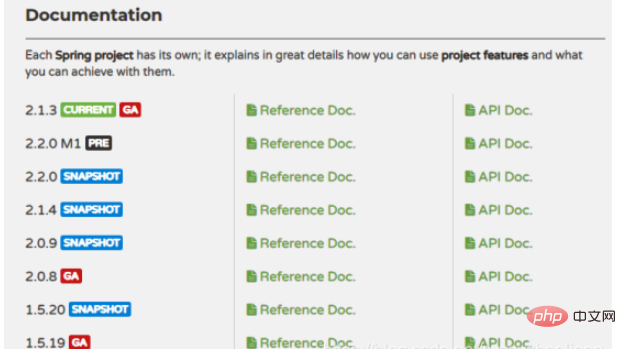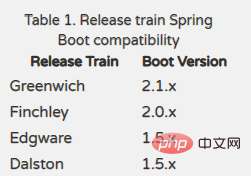What are the advantages and disadvantages of SpringBoot and Spring?
Comparison between SpringBoot and Spring
Analysis of the advantages and disadvantages of the original Spring
1. Analysis of the advantages of Spring
Spring is a lightweight replacement for Java Enterprise Edition (JEE, also known as J2EE). There is no need to develop heavyweight EnterpriseJavaBean (EJB). Spring provides a relatively simple method for enterprise-level Java development. Through dependency injection and aspect-oriented programming, EJB is implemented with simple Java objects (Plain Old Java Object, POJO). Function.
2. Analysis of Spring's shortcomings
Although Spring's component code is lightweight, its configuration is heavyweight. In the beginning, Spring used XML configuration, and a lot of XML configuration. Spring 2.5 introduces annotation-based component scanning, which eliminates a lot of explicit XML configuration for the application's own components. Spring 3.0 introduces Java-based configuration, a type-safe, reconfigurable alternative to XML.
All these configurations represent development losses. Because of the need to switch between thinking about Spring feature configuration and solving business problems, writing configuration takes time away from writing application logic. Like all frameworks, Spring is practical, but at the same time it demands a lot in return.
In addition, project dependency management is also a time-consuming and labor-intensive matter. When setting up the environment, it is necessary to analyze the coordinates of which libraries are to be imported, and also the coordinates of other libraries that are dependent on it. Once the wrong dependent version is selected, the ensuing incompatibility problems will seriously hinder The development progress of the project.
Overview of SpringBoot
1.SpringBoot solves the above shortcomings of Spring
SpringBoot improves and optimizes the above shortcomings of Spring, based on the agreed advantages The idea of focusing on configuration allows developers to not have to switch their thinking between configuration and logical business, but to devote themselves wholeheartedly to writing code for logical business, thereby greatly improving development efficiency and shortening the project cycle to a certain extent.
2. Features of SpringBoot
Provides a faster entry experience for Spring-based development out of the box, with no code generation and no XML configuration. At the same time, the default values can also be modified to meet specific needs. It provides some non-functional features common in large projects, such as embedded servers, security, indicators, health detection, external configuration, etc. SpringBoot is not an enhancement of Spring functions; Provides a quick way to use Spring.
Core functions of SpringBoot
1. Starting dependency
Starting dependency is essentially a Maven Project Object Model (POM), Defines transitive dependencies on other libraries, which together support a certain function. Simply put, the starting dependency is to package coordinates with certain functions together and provide some default functions.
2. Automatic configuration
Spring Boot’s automatic configuration is a runtime (more precisely, when the application starts) process, taking into account many factors , to decide which Spring configuration should be used and which one should not be used. This process is completed automatically by Spring.
Correspondence between SpringBoot and springcloud versions
Springboot official version:

springCloud official version:

Corresponding relationship:

The above is the detailed content of What are the advantages and disadvantages of SpringBoot and Spring?. For more information, please follow other related articles on the PHP Chinese website!

Hot AI Tools

Undresser.AI Undress
AI-powered app for creating realistic nude photos

AI Clothes Remover
Online AI tool for removing clothes from photos.

Undress AI Tool
Undress images for free

Clothoff.io
AI clothes remover

Video Face Swap
Swap faces in any video effortlessly with our completely free AI face swap tool!

Hot Article

Hot Tools

Notepad++7.3.1
Easy-to-use and free code editor

SublimeText3 Chinese version
Chinese version, very easy to use

Zend Studio 13.0.1
Powerful PHP integrated development environment

Dreamweaver CS6
Visual web development tools

SublimeText3 Mac version
God-level code editing software (SublimeText3)

Hot Topics
 1386
1386
 52
52
 A new programming paradigm, when Spring Boot meets OpenAI
Feb 01, 2024 pm 09:18 PM
A new programming paradigm, when Spring Boot meets OpenAI
Feb 01, 2024 pm 09:18 PM
In 2023, AI technology has become a hot topic and has a huge impact on various industries, especially in the programming field. People are increasingly aware of the importance of AI technology, and the Spring community is no exception. With the continuous advancement of GenAI (General Artificial Intelligence) technology, it has become crucial and urgent to simplify the creation of applications with AI functions. Against this background, "SpringAI" emerged, aiming to simplify the process of developing AI functional applications, making it simple and intuitive and avoiding unnecessary complexity. Through "SpringAI", developers can more easily build applications with AI functions, making them easier to use and operate.
 Use Spring Boot and Spring AI to build generative artificial intelligence applications
Apr 28, 2024 am 11:46 AM
Use Spring Boot and Spring AI to build generative artificial intelligence applications
Apr 28, 2024 am 11:46 AM
As an industry leader, Spring+AI provides leading solutions for various industries through its powerful, flexible API and advanced functions. In this topic, we will delve into the application examples of Spring+AI in various fields. Each case will show how Spring+AI meets specific needs, achieves goals, and extends these LESSONSLEARNED to a wider range of applications. I hope this topic can inspire you to understand and utilize the infinite possibilities of Spring+AI more deeply. The Spring framework has a history of more than 20 years in the field of software development, and it has been 10 years since the Spring Boot 1.0 version was released. Now, no one can dispute that Spring
 What are the implementation methods of spring programmatic transactions?
Jan 08, 2024 am 10:23 AM
What are the implementation methods of spring programmatic transactions?
Jan 08, 2024 am 10:23 AM
How to implement spring programmatic transactions: 1. Use TransactionTemplate; 2. Use TransactionCallback and TransactionCallbackWithoutResult; 3. Use Transactional annotations; 4. Use TransactionTemplate in combination with @Transactional; 5. Customize the transaction manager.
 Comparison and difference analysis between SpringBoot and SpringMVC
Dec 29, 2023 am 11:02 AM
Comparison and difference analysis between SpringBoot and SpringMVC
Dec 29, 2023 am 11:02 AM
SpringBoot and SpringMVC are both commonly used frameworks in Java development, but there are some obvious differences between them. This article will explore the features and uses of these two frameworks and compare their differences. First, let's learn about SpringBoot. SpringBoot was developed by the Pivotal team to simplify the creation and deployment of applications based on the Spring framework. It provides a fast, lightweight way to build stand-alone, executable
 The 7 most commonly used annotations in Spring, the most powerful organization in history!
Jul 26, 2023 pm 04:38 PM
The 7 most commonly used annotations in Spring, the most powerful organization in history!
Jul 26, 2023 pm 04:38 PM
With the update and iteration of technology, Java5.0 began to support annotations. As the leading framework in Java, spring has slowly begun to abandon xml configuration since it was updated to version 2.5, and more annotations are used to control the spring framework.
 SpringBoot+Dubbo+Nacos development practical tutorial
Aug 15, 2023 pm 04:49 PM
SpringBoot+Dubbo+Nacos development practical tutorial
Aug 15, 2023 pm 04:49 PM
This article will write a detailed example to talk about the actual development of dubbo+nacos+Spring Boot. This article will not cover too much theoretical knowledge, but will write the simplest example to illustrate how dubbo can be integrated with nacos to quickly build a development environment.
 How to set transaction isolation level in Spring
Jan 26, 2024 pm 05:38 PM
How to set transaction isolation level in Spring
Jan 26, 2024 pm 05:38 PM
How to set the transaction isolation level in Spring: 1. Use the @Transactional annotation; 2. Set it in the Spring configuration file; 3. Use PlatformTransactionManager; 4. Set it in the Java configuration class. Detailed introduction: 1. Use the @Transactional annotation, add the @Transactional annotation to the class or method that requires transaction management, and set the isolation level in the attribute; 2. In the Spring configuration file, etc.
 Spring Annotation Revealed: Analysis of Common Annotations
Dec 30, 2023 am 11:28 AM
Spring Annotation Revealed: Analysis of Common Annotations
Dec 30, 2023 am 11:28 AM
Spring is an open source framework that provides many annotations to simplify and enhance Java development. This article will explain commonly used Spring annotations in detail and provide specific code examples. @Autowired: Autowired @Autowired annotation can be used to automatically wire beans in the Spring container. When we use the @Autowired annotation where dependencies are required, Spring will find matching beans in the container and automatically inject them. The sample code is as follows: @Auto




